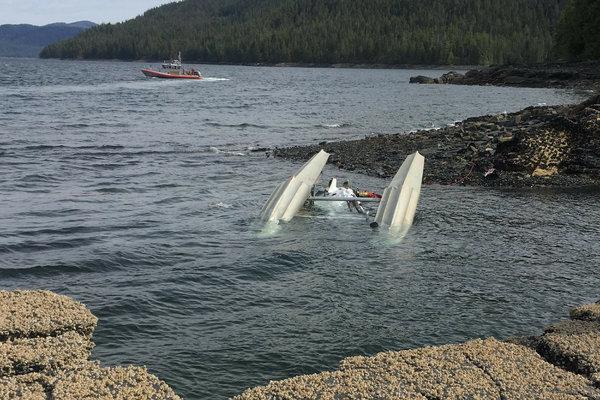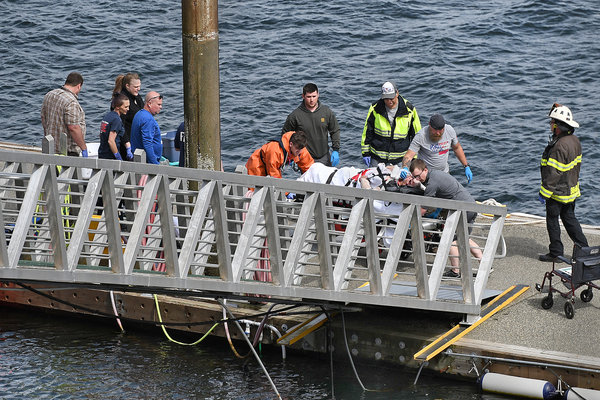
Coast Guard members searched for survivors from one of the downed aircraft near Ketchikan, Alaska, on Monday. CreditReuters
When two propeller planes crashed in southeast Alaska on Monday, killing six people, aviation experts said they were saddened, but not surprised.
The accident, which also left 10 injured, was among many involving small planes in the United States in recent months. This alarming frequency has raised questions about the level of regulation applied to planes operated by private pilots and smaller companies, which is less stringent than that for large commercial aircraft.
Earlier this month two people were injured when a small plane crashed near the Gulf Coast of Alabama. A week before, two people aboard another small aircraft departing La Center, Wash., were killed when the plane crashed. That same week, two others died when a small plane crashed in Madera California.
“It is really disconcerting to learn about all the prior accidents with these planes,” said Jack Hickey, a maritime lawyer. “There are a lot of these accidents involving private aviation and after National Transportation Security Board completes its investigation, there should be more talk about more regulation.”
What kinds of flights were involved in Alaska?
Both planes in the Alaska tragedy carried passengers from a Princess Cruises ship. One plane, a de Havilland Otter seaplane operated by Taquan Air, had 10 passengers and a pilot onboard, and was returning from an excursion organized and sold through the cruise line. Four cruise passengers and a pilot were on the other plane, a de Havilland DHC-2 Beaver, on an independent tour.
The Taquan Air flight was a commercial flight, while the smaller plane was what is known as a “general aviation” flight, which is how the F.A.A. categorizes flights that are not on commercial airlines. Commuter and charter flights both fall into this category, which is known as “part 135.” Private planes owned by individuals belong to “part 91” and regional and major airlines belong in “part 121.” The “parts” refer to different parts of the Federal Aviation Regulations, and the categories help to determine the level of training required for pilots.
And although general aviation is safer now than it has been historically, it is still more dangerous than commercial air travel.
What’s the difference in regulations?
Pilots on commercial planes, or part 121 aircraft, have more stringent training and flight-readiness requirements.
“Training elements are more robust for 121’s,” said John Goglia, a former N.T.S.B member. Commercial pilots, he said, are required to attend training each year.
“If you’re a private pilot and you’ve had a heart attack and you’ve had a couple of years of no issues, you can get a certificate to fly again,” he said. “Not happening if you’re a 121.”
Private planes typically do not have extra engines, backup navigation systems or co-pilots. Many have one engine. They are not required to supply designated flight paths for those on the ground to follow. Rules and regulations pertaining to smaller, private planes tend to be less stringent than those affecting commercial planes, because they do not put the same number of lives at risk.
Planes with ten or more passengers are held to a higher standard those with fewer than ten.
“Commercial planes are holding themselves out to be operating at the highest levels of safety,” said Mr. Goglia. “That’s not required of most others. And part of it has to do with the number of passengers.”

What happened in the other recent crashes?
Most of them involved private pilots, many flying their own planes. Comparing these kinds of flights to commercial aviation, is not the most accurate way to think about them, said Earl Weener, a member of the N.T.S.B.
“It’s a much different operation,” Mr. Weener said.
“The airline community is highly regulated, it’s routinized in that airline pilots are flying into the same airports regularly,” he said. “That’s different than somebody who owns their own plane and uses it for recreational travel, personal travel.” (Mr. Weener could not comment on the Alaska crash specifically, but spoke broadly about the safety concerns regarding private planes).
In studies done in the last decade, the N.T.S.B. found that a main cause of accidents on private planes was “loss of control”; the organization has been working with pilots’ organizations to address that issue in particular.
“The regulations on general aviation have slowly tightened over the years,” said John Cox, a former airline pilot and now a safety consultant.
Mr. Cox and others said it would be premature to suggest that regulations should be changed before it is clear what exactly caused the accident in Alaska. N.T.S.B. officials are currently investigating and the safety board declined to comment. The day was overcast with winds from the southeast at 9 m.p.h.
How common are the cruise flights?
Glacier flights have become a popular add-on for Alaska cruise passengers. On its website, Princess Cruises suggests adding a glacier “flightseeing” trip to your “must-see list.”
The cruise line asks, “Why sightsee when you can flightsee? Flightseeing, also known as flight touring, grants you a bird’s-eye view of the beauty infused into Alaska’s natural landscapes.”
Robert W. Mann, an airline industry consultant in Port Washington, N.Y., said that he was once on a trip similar to the one on Monday and it was easy for him to understand how an accident could happen.
“You’re located on a body of water next to glacial activity, so there’s almost always some low clouds in that area,” he said. “But there’s a lot of pressure to perform because people take these journeys and they pay. I imagine all these things kind of factor together.”
Princess did not return requests for comment, but Brian O’Connor, a spokesman for the company, said in a statement, “All of us at Princess Cruises are deeply saddened by this tragic news and we are extending our full support to the investigating authorities as well as the traveling companions of the guests involved.”
Follow NY Times Travel on Twitter, Instagram and Facebook. Get weekly updates from our Travel Dispatch newsletter, with tips on traveling smarter, destination coverage and photos from all over the world.






